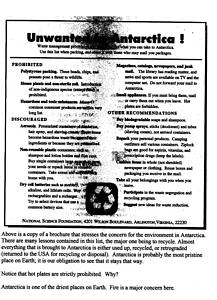
|
|
18 October, 1999
Here I am tonight exactly two weeks before a leave for Antarctica. The
goal tonight is described a little bit more about the McMurdo Sound Base.
This base, one of three in Antarctica, is the largest. Approximately 90
percent of all the United States Antarctic program parcticipants either
reside at, or pass through McMurdo Sound. The austral winter (our summer)
population ranges from 150 to 170 whereas in the summertime the population
could reach 1100. The station is normally isolated from late February
until early October, except for a brief time in August when several
closely spaced flights (known as WINFLY for winter flights) deliver
personnel, supplies, and the early science parties.
McMurdo had its three airfields that are used at different times for
different reasons. Williams Field is a ski way 68 kilometers >from the
base on theRoss Ice Shelf, it is the aerodrome for ski the equipped
airplanes. The ice runway is used for wheeled airplanes and is a harder,
and smoother runway on the sea ice, but it can be used only from late
September early December, before the sea ice softens and becomes
unusable. A permanent blue ice runway, the Pegasus site on the Ross Ice
Shelf, was first used in early 1993, and can be used by wheel airplanes
but is farther >from McMurdo. Among its advantages, it enables LC-130s
too take off with heavier payloads than allowed for ski takeoffs.
McMurdo also has a heliport at the edge of town.
McMurdo Sound is a historic area. On his voyage o 1839-1840, James Clark
Ross brought his ships Erebus and Terror into the sound before sailing
eastward along the front of the great ice shelf that now bears his name.
In 1901, Robert Falcon Scott wintered the Discovery in winter Quarters
Bay, adjacent to the station. He built a hut here in 1901 and it still
stands. I hope to get some picture of that hut and send them back to you
whenI get there Scott in 1901-1903 and Ernest Shakleton in 1914-1916
deployed their sledging partiers >from this general area.
McMurdo Sound sits in the immediate view of Mount Erebus a 3,794-meter
high active volcano. (3794 m X 100cm/m X 1 in/2.54cm x 1 ft/12 in = the #
of feet). This volcano has been used to develop and test "landers � and
rovers" � that might be used on Mars when we go there. The extremes in
temperatures on the inside and outside of the volcano emulate conditions
that are believed to exist on certain other planets.
Accommodations at the base are pretty much dormitory style, with a common
bathroom. The are unusually 2 or3 people per room. Due to round the clock
operations of the base roommates frequently have totally different
schedules, making "quiet time" a most important part of the daily life.
Electric power is supplied by generators that supply 120 volt, 60 hertz
electrical power, the same as in the USA. Water is obtained by reverse
osmosis of seawater. This is much cheaper (dollars and fuel wise) then
trying to distill it. Use of water for showers and laundry must be
carefully monitored.
There is a satellite phone system; but, it is reserved for pre-approved
incoming calls. Outgoing calls can be made; but, only on a limited basis.
Recreation includes a library, clubs, gym, weight room, aerobics room,
band room, and bowling alley.
There is a laundry facility available for use at any time.
Food service provides four meals a day: breakfast, lunch, dinner and
midnight meals ("midrats").
There is a full time doctor and dentist on base during the summer, but,
only an MD during the winter.
The science facility at McMurdo is new, opened in 1991 and named the
Albert P. Crarey Science and Engineering Center (CSEC). This 4320 square
meter facility houses: telescience, computer room, conference rooms,
lounges, analytical chemistry lab, snow and ice labs, general use labs, a
storage/receiving and staging area, chemistry labs, microbiology labs,
radioisotope lab, walk in freezers, chemical storage, environmental rooms,
field-party staging areas, electronics workshop, Faraday cage, darkroom,
GPS instrument room, sectioning room, SAR ground station, and aquarium and
holding tank and offices.
Waste management is a major concern and strict guidelines exist and are
followed to a "T"�. All wastes are now retrograded out of Antarctica. See
arcticle below.
Time is a flying and I must get ready for my first attempt at a
Cu-You-See-Me computer video/audio conference. Once we get this to work we
will bring it with us to Anarctica and attempt to have at least two live
broadcasts from The Ice.
Ciao, for now.
Question, true or false? There are ATM machines at McMurdo Sound Station???

Contact the TEA in the field at
.
If you cannot connect through your browser, copy the
TEA's e-mail address in the "To:" line of
your favorite e-mail package.
|
